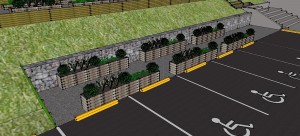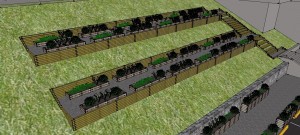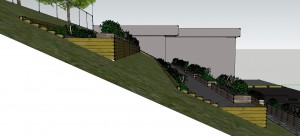Evan has been hard at work this past week putting together the SketchUp model of our team’s initial “optimal design”. We chose to illustrate our design using Google SketchUp, creating a very visually appealing, and scale accurate, model.

Our design encorporates a three-teir system, with a wheelchair accessible ground level, and two raised upper levels. Retaining walls will not exceed more than 4 feet in height, so as to eliminate the need to hire a Structural Engineer. Each level is approximately 9 feet deep, with slope distances stretching about 6.5 feet between each level.
As illustrated by the textures seen in the model, the first set of retaining walls will be made of gabion blocks. This provides extra slope stabalization.
The two upper level retaining walls have been designed with wooden supports. Each level features 3 feet of planter boxes on either side of a 3 foot pathway.
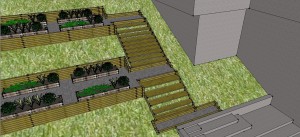
The concrete stairs seen at the side of the slope are pre-existing, but, as the levels are built up, a wooden stairway will be built to provide safe access to the upper tiers.

Overall, our garden could encorporate upwards of 30 plots. Levels could be built on a need-basis, with upper teirs being added as the demand for plots – or the gathered funds necessary to finanace their construction – increases.
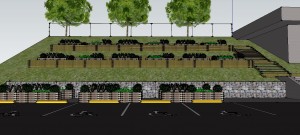
The garden has been designed to be functional, accessible, cost efficient, sustainable, and easily maintained. Utilities needed to maintain the garden – such as a water supply – can be tapped from the neighboring building (whose outer wall can be seen on the right hand side of the above picture), and tools can be stored either under planter boxes or in a seperate storage space.
Larger versions of the pictures seen in this post can be found here:
(http://www.flickr.com/photos/93598295@N03/sets/72157632881870573/)

